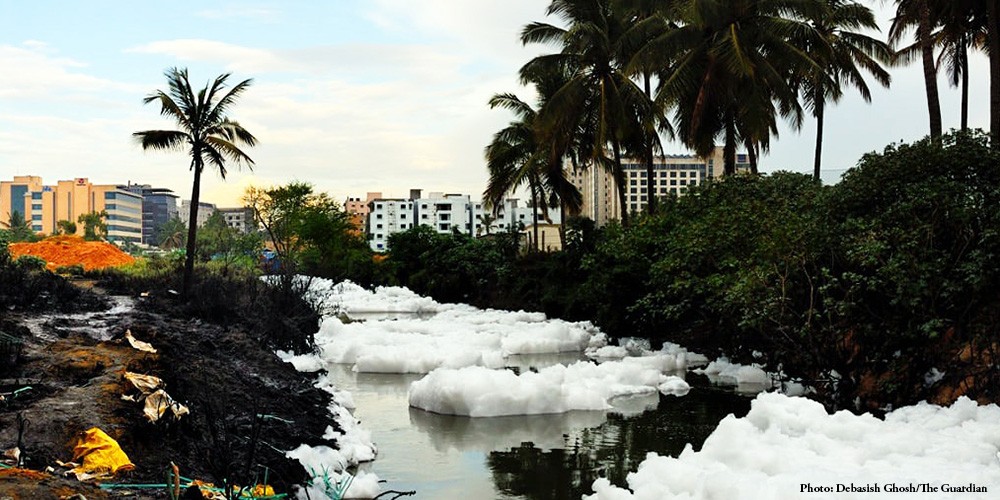Regenerating Urban lakes

Most discussions on water supply and shortage in cities focus on rainfall, rivers, and piped water supply. Lakes rarely find a mention in this urban water story, though they form a significant part of the urban ecosystem, playing a crucial role in water storage, groundwater recharge, biodiversity, and as a buffer against floods.
As part of its ongoing series investigating issues related to groundwater, Columbia Global Centers | Mumbai hosted a lecture by Dr. Veena Srinivasan, a Fellow at the Ashoka Trust for Research in Ecology and the Environment (ATREE) on October 4, 2017. Dr. Srinivasan presented her research on Bengaluru’s lakes and addressed the role of lakes in the urban water system.
Bengaluru is colloquially referred to as the ‘City of Lakes’ and serves as a fitting backdrop for examining this ecosystem. Dr. Srinivasan traced the colonial history and trajectory of lakes in Bengaluru from their origins as seasonal irrigation tanks around the 5th-7th Century BC to their contemporary usage in cultural and citizen activities such as idol immersion. “Lakes in Bengaluru have been in the news for all the wrong reasons with Varthur and Bellandur lakes catching fire and the reports of fish dying in Ulsoor Lake. These recent incidents underline what is happening and why we should be thinking of lakes in the broader context of water security of our cities,” she said.
Dr. Srinivasan explained that the city of Bengaluru developed along its outskirts, often swallowing up peri-urban areas in its development path and subsequently altered the trajectory of water resources such as lakes. Like in most other Indian cities, the sewage treatment facilities didn’t keep pace with the burgeoning population, leaving at least two-thirds of the city’s sewage untreated. Rivers were reduced to drains. While lakes upstream have run dry due to changes in rainfall patterns, downstream lakes in the heart of the city are polluted and full of sewage. People rarely think about what goes into the vegetables and milk they are eating as a result of this polluted water chain.
“We often think of urban water supply in linear terms,” said Dr. Srinivasan. Most city water systems are conceptualised on the premise that you get water from distant sources, bring it to treatment plants in the city for chlorination and pump it through pipes to urban residents; the wastewater is then treated in sewage plants and disposed to some other water body. Lakes are considered separate in this chain, as storage structures for rainwater, while allowing some of it to flow into streams and the rest to land up in sewage treatment plants. “In reality, this isn’t the typical path in most Indian cities; water body linkages are more complicated. This is why we need science to study the data and look at all water sources holistically,” said Dr. Srinivasan. She explained how lakes were connected to the circular water economy, not only for their recharge of groundwater, but also through evaporation of water into the atmosphere.
Over the years, the encroachment along the periphery of lakes and poor regulation due to multiple government agencies has led to further deterioration of these water bodies. “During our research at ATREE, we learnt that the pollution control board was sampling water for testing by day, but industries were polluting by night,” pointed out Dr. Srinivasan. Ownership of lakes is split between the municipal and metropolitan authorities, and management could involve additional agencies such as the pollution control board, water supply and sewerage board, the lake development authority, and the forest and fisheries department.
Dr. Srinivasan shared how citizens in Bengaluru have now started engaging with the upkeep of lakes in their neighbourhood, by managing data and monitoring the condition of lakes as well as increasing awareness on the need to prevent immersion in lakes. She also suggested the use of technology for sewage separation at source (toilet-level) towards planning our cities more efficiently in the future.
Her lecture was followed by a discussion with Dr. Urjit A. Yajnik, Institute Chair Professor, Department of Physics, IIT Bombay, who played a key role in IIT Bombay’s Class of 1980 ‘Revitalization of Powai Lake’ initiative. He outlined how the active involvement of citizens had led to some improvements in the condition of the Mumbai lake, but much more was still required towards truly achieving a circular water economy.